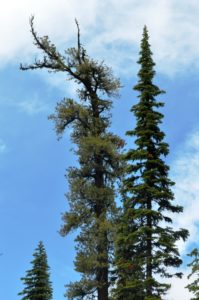2012 Operational WBP Cone Collection, Yellowstone Club
Project: Operational Whitebark pine cone collection, Yellowstone Club
Attachment: Various_Gannon_2012_Progress report – July 2012
Agency/Forest or Park/District: Yellowstone Club, Big Sky, Montana, Madison County
 Project coordinator: Amy Gannon
Project coordinator: Amy Gannon
Contact: Amy Gannon; Montana Department of Natural Resources and Conservation; 2705 Spurgin Road, Missoula, MT 59804; (406)542-4283; agannon@mt.gov
Cooperators
Luke Stratford, Yellowstone Club
Source of funding /amount
FHP: $4,000
Supplemental funding: $4,000 from DNRC and Yellowstone Club
Dates of restoration efforts
Summer 2012
Objectives
To perpetuate local presence of whitebark pine in a landscape impacted by a mountain pine beetle outbreak by collecting seeds from remaining mature trees for future planting efforts.
Acres/ha treated
100 acres (collecting cones from approximately 20 trees)
Methods
Initial survey of the cone crop will be conducted by Yellowstone Club personnel or a consulting forester in the spring of 2012 (approximately May) to determine whether or not cone abundance will be adequate for a caging and collection effort. Snowmobiles or skis will likely be required for access at that time of year but since the site is at a developed ski area, the survey could be completed well within a day. If determined that there is an adequate cone crop, supplies and contracts will be developed. The Stubbs and Berrang style cages will be made by DNRC personnel using 1/8” inch hardware cloth and duct tape. The contract will be written in advance, put out to bid immediately, awarded to the contractor and finalized by the end of June. The contract will likely require two-person roped climbing crews. If access to crop trees is reasonably near roads, we will contract for a mechanical lift truck (to ensure safety and reduce cost). Tree tongs are not an option due to the height of the trees and the high winds in the area. In July, crews will cage the cones and collection trees will be tagged with their GPS coordinates mapped. The area does not have a moderate to high level of white pine blister rust therefore; we cannot effectively select select for trees demonstrating resistance. Nonetheless, we will preferentially choose trees that have little to no apparent infection and are free of mountain pine beetle. In October, cages and cones will be retrieved. (Access is not particularly limited by weather so collection will be later in the typical window to ensure ripeness.) At least one person will be on the ground at all times to assist with cone and cage collection logistics and data recording. Seed will be stored in the DNRC Conservation Seedling Nursery seed cooler until germination or outplanting is appropriate. Recent and ongoing studies will be referenced to determine the best method.
Planting? If so, source of seedlings? Resistance? No
Outcome
In winter 2012: There was not an adequate cone crop for the first year of the project therefore; no caging or collection was done. Plans are in place to try again in 2013 if an adequate cone crop exists.
Arrangements are currently underway to acquire 8500 seed from the Greater Yellowstone Ecosystem. The Bridger-Teton Forest is offering seed and the DNRC and Yellowstone Club are trying to resolve payment and in-kind contribution options.
We have been monitoring the development of cones and found few viable trees since receiving the grant.
Once seed direct-seeding occurs, we intend to monitor the site for survival.
These outcomes will meet the original goal of establishing whitebark pine on the site.
Miscellaneous comments
We had an excellent cone crop in 2011 but no funding to do the caging or collection. The cone crop in 2012 was inadequate so, despite available funding, we were not able to cage or collect.